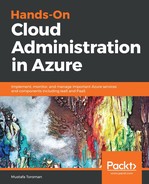To use our own key for Azure SQL Database TDE, we must execute a few commands.
First, we need to sign our Azure Active Directory identity in to our Azure SQL server:
$dbRG = 'PacktPaaSDB';
$dbServer = 'packt';
$server = Set-AzureRmSqlServer -ResourceGroupName $dbRG -ServerName $dbServer -AssignIdentity
Second, we must grant Key Vault permission to our server:
$dbRG = 'PacktPaaSDB';
$dbServer = 'packt';
$KeyVaultName = 'PacktKV';
Set-AzureRmKeyVaultAccessPolicy -VaultName $KeyVaultName -ObjectId $server.Identity.PrincipalId -PermissionsToKeys get, wrapKey, unwrapKey
Third, we add the Key Vault key to the server and set the TDE protection level:
$dbRG = 'PacktPaaSDB';
$dbServer = 'packt';
$rgName = 'PacktKeyVault';
$KeyVaultName = 'PacktKV';
$keyEncryptionKeyName = 'MyKey';
$keyEncryptionKeyUrl = (Get-AzureKeyVaultKey -VaultName $KeyVaultName -Name $keyEncryptionKeyName).Key.kid;
<# Add the key from Key Vault to the server #>
Add-AzureRmSqlServerKeyVaultKey -ResourceGroupName $dbRG -ServerName $dbServer -KeyId $keyEncryptionKeyUrl
<# Set the key as the TDE protector for all resources under the server #>
Set-AzureRmSqlServerTransparentDataEncryptionProtector -ResourceGroupName $dbRG -ServerName $dbServer -Type AzureKeyVault -KeyId $keyEncryptionKeyUrl
<# To confirm that the TDE protector was configured as intended: #>
Get-AzureRmSqlServerTransparentDataEncryptionProtector -ResourceGroupName $dbRG -ServerName $dbServer
Finally, we turn on the TDE:
$dbRG = 'PacktPaaSDB';
$dbServer = 'packt';
$dbName = 'Demo'
Set-AzureRMSqlDatabaseTransparentDataEncryption -ResourceGroupName $dbRG -ServerName $dbServer -DatabaseName $dbName -State "Enabled"
All parameters in Azure PowerShell script can be edited. To execute this on any Azure SQL Database using any Key Vault, change the names of the parameters accordingly.
